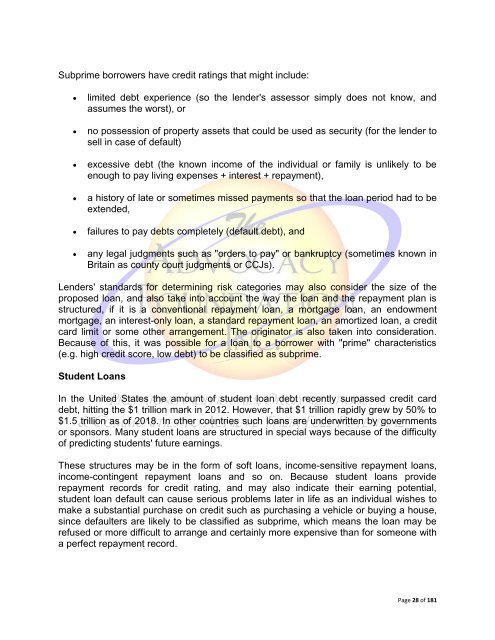Create successful ePaper yourself
Turn your PDF publications into a flip-book with our unique Google optimized e-Paper software.
Subprime borrowers have credit ratings that might include:<br />
<br />
<br />
<br />
<br />
<br />
<br />
limited debt experience (so the lender's assessor simply does not know, and<br />
assumes the worst), or<br />
no possession of property assets that could be used as security (for the lender to<br />
sell in case of default)<br />
excessive debt (the known income of the individual or family is unlikely to be<br />
enough to pay living expenses + interest + repayment),<br />
a history of late or sometimes missed payments so that the loan period had to be<br />
extended,<br />
failures to pay debts completely (default debt), and<br />
any legal judgments such as "orders to pay" or bankruptcy (sometimes known in<br />
Britain as county court judgments or CCJs).<br />
Lenders' standards for determining risk categories may also consider the size of the<br />
proposed loan, and also take into account the way the loan and the repayment plan is<br />
structured, if it is a conventional repayment loan, a mortgage loan, an endowment<br />
mortgage, an interest-only loan, a standard repayment loan, an amortized loan, a credit<br />
card limit or some other arrangement. The originator is also taken into consideration.<br />
Because of this, it was possible for a loan to a borrower with "prime" characteristics<br />
(e.g. high credit score, low debt) to be classified as subprime.<br />
Student Loans<br />
In the United States the amount of student loan debt recently surpassed credit card<br />
debt, hitting the $1 trillion mark in 2012. However, that $1 trillion rapidly grew by 50% to<br />
$1.5 trillion as of 2018. In other countries such loans are underwritten by governments<br />
or sponsors. Many student loans are structured in special ways because of the difficulty<br />
of predicting students' future earnings.<br />
These structures may be in the form of soft loans, income-sensitive repayment loans,<br />
income-contingent repayment loans and so on. Because student loans provide<br />
repayment records for credit rating, and may also indicate their earning potential,<br />
student loan default can cause serious problems later in life as an individual wishes to<br />
make a substantial purchase on credit such as purchasing a vehicle or buying a house,<br />
since defaulters are likely to be classified as subprime, which means the loan may be<br />
refused or more difficult to arrange and certainly more expensive than for someone with<br />
a perfect repayment record.<br />
Page 28 of 181

















